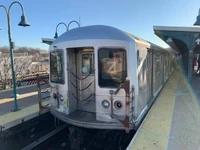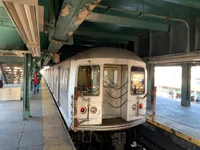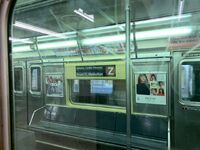The R42 was a New York City Subway car model built by the St. Louis Car Company between 1969 and 1970 for the IND/BMT B Division. There were 400 cars in the R42 fleet, numbered 4550–4949. It was the last 60-foot (18.29 m) B Division car built for the New York City Subway until the R143 in 2001, and the last car model class to be built in married pairs.
The first R42 cars entered service on May 9, 1969. Various modifications were made over the years to the R42 fleet. In the late 1980s, the R42 cars were rebuilt by Morrison–Knudsen and the Coney Island Rapid Transit Car Overhaul Shop. The R160 order was to replace all R42s in the late 2000s, but 50 cars of the original fleet remained, when it was decided to retire the NYCT R44s instead. The R211 order replaced the remainder of the R42s in the early 2020s, and the final train of R42s ran in passenger service on December 31, 2023. After retirement, most of the cars were sunk as artificial reefs, scrapped, or placed into storage, but a handful have been preserved and others retained for various purposes.
Description[]
The R42s are numbered 4550–4949. They were the first fleet of New York City Subway cars to be fully equipped with Stone Safety 10 ton air conditioning systems/units. and became standard equipment on all future subway cars purchased from this point onward. As a result of the air conditioning, the standee poles were arranged in an alternating pattern rather than the straight-line pattern seen in the R40s, which lacked air conditioning systems/units until their overhauls.
The R42s were also the first cars to use solid state converters in place of the motor-generators as standard equipment, and were also the last cars to be equipped with the tried-and-true, and extremely reliable WABCO RT-2 or SMEE braking system temporarily, until returning in 1983 with the R62s for the IRT division, after disastrous results with the newer WABCO RT-5 or P-Wire braking systems used on their R44 and R46 cars of the 1970s. The R42s were built with the non-sloping design that is used on all other subway cars in the Transit Authority's attempt to modified the safety hazards and concerns previously found on the R40 model. They were also the last cars to not have the two-note warning chime that was present on the R44 and all of the train models following it.
History[]
On May 9, 1969, cars 4550-4559 entered service on the N. By January 5, 1970, all cars were in service.
Post-delivery and overhaul[]
Initially, the R42s suffered from air conditioning and brake malfunctions, frequently injuring crew members.
In 1973, cars 4764–4765 were sent to Garrett AiResearch's facilities in Los Angeles, California, to test out an experimental flywheel energy storage and energy-saving system and equipment. Car 4764 received this energy storage, conservation equipment, and machinery with batteries and amber-type digital readouts indicating the amount of energy used by the equipment, while 4765 remained untouched. These cars were later tested at the UMTA and the USDOT testing facility in Pueblo, Colorado for evaluation, before being returned to the MTA in 1976 for in-service testing on all BMT/IND lines to check the effectiveness of the technology.
In 1977, pantograph gates, salvaged from retired R1 through R9 cars, were modified and installed on the front ends of the R42s. Baloney coiled spring type inter car safety barriers were also installed on the blind ends of the married pairs.
Between 1988 and 1989, the R42s underwent overhaul as a result of deferred maintenance in the New York City Subway during the 1970s and the 1980s. 282 cars (most cars from 4550 to 4839) were overhauled by Morrison–Knudsen, while the last 110 cars (4840–4949) were rebuilt in-house by the Coney Island Rapid Transit Car Overhaul Shop in Brooklyn. Notable changes from the overhaul included the replacement of the original doors by stainless steel doors with smaller windows. Morrison–Knudsen also removed the blue door indicator lights at the ends of the cars, but kept the original Westinghouse XM829 master controllers in their cabs. The Coney Island rebuilds retained their blue indicator lights.
Retirement[]
Initial retirements[]
The R160s replaced the vast majority of the R42s. All of the Coney Island-rebuilt cars were retired first from July 2007 to May 2008 due to various structural and braking issues that plagued them throughout their rebuilt lifespan. Subsequently, most Morrison–Knudsen-rebuilt cars followed from December 2008 until December 2009, when it was decided to retire the NYCT R44s instead. 50 cars (4788–4817 and 4820–4839) remained and were assigned to East New York Yard, operating on the J and Z. These 50 cars periodically underwent SMS (Scheduled Maintenance Service, a life extension program) cycles.
The R211s replaced the remainder of the R42s. Since the delivery of the four-car R211 sets, demand for the R42s drastically lowered. By January 2021, they were no longer formally assigned for revenue service, becoming a contingency fleet. In late May 2021, 14 of the cars were transferred to 207th Street Yard and 10 of which ran on the A until June 30, 2023. After six months in storage, the R42s were officially retired on December 31, 2023 when the last train made its final trip on the N as part of a ceremonial farewell excursion sponsored by the New York Transit Museum.
Following retirement, nearly all cars retired by the R160s were stripped of parts and sunk as artificial reefs. After the reefing program ended in April 2010, leftover retired R42s were trucked to Sims Metal Management's Newark facility to be scrapped and processed in mid-2013.
Several retired R42 cars were saved for various purposes throughout the New York City Subway system, including:
- 4554-4555 - donated to Transit Tech High School's Railcar Lab on April 14, 2009, replacing R30 car 8337, which was reefed a few months later.
- 4572-4573 - preserved, repainted, and set aside for the New York Transit Museum. This set was used in the famous chase scene in the film, The French Connection. The cars have been used on several recent NYTM fan trips, specifically as a part of the Train of Many Metals (TOMM).
- 4604-4613 - taken out of revenue service in December 2009 and are now used for work service; six of these cars are based from the 36th-38th Street Yard, while the other four are based from the 207th Street Yard. All cars handle such tasks as providing traction for B Division rail adhesion cars and refuse trains.
- 4650-4651 - being used as NYPD training cars at Floyd Bennett Field.
- 4664-4665 - preserved by the Railway Preservation Corp. The pair is stored at Coney Island Yard.
- 4760-4761 - being used as derailment re-railing training cars at the Coney Island Complex.







